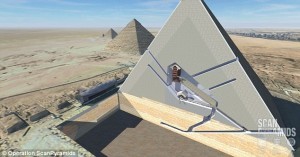The mystery of a 4,500-year-old “huge void” deep within the Great Pyramid of Giza has been revealed, archaeologists claim.
After translating ancient texts, researchers believe an “iron throne” made of meteorites may sit within the giant chamber which was uncovered using revolutionary scanning technology.
The Polytechnic University of Milan’s Giulio Magli said: “There is a possible interpretation, which is in good agreement with what we know about the Egyptian funerary religion as witnessed in the Pyramids Texts.
“In these texts it is said that the pharaoh, before reaching the stars of the north, will have to pass the ‘gates of the sky’ and sit on his ‘throne of iron’.”
After interpreting an ancient text the researchers believe the iron throne may have been made from meteorites as the structure was built before the iron age.
Ancient Egyptians often used iron from meteorites to coat precious items for pharaohs as they were incapable of smelting it themselves.
The researcher said: “Of course it would not be melted iron, but meteoritic iron, that is, fallen from the sky in the form of Iron meteorites (distinguishable due to the high percentage of Nickel) and again cited in the Texts.”
It is believed the iron throne sits in the chamber which is at least 30 metres long.
When the void was discovered in 2017 researchers said it constituted the first major inner structure found in the Great Pyramid since the 19th century.
Using an imaging method and a robot based on cosmic rays scientists uncovered the mysteries of the pyramid.
Scientists built the probe that entered the 3.5cm keyhole in a wall after a large and enigmatic internal structure was detected in the last of the Seven Wonders of the Ancient World still standing.
Mehdi Tayoubi, president and co-founder of the HIP Institute in France said: “What we are sure about is that this big void is there, that it is impressive, that it was not expected by, as far as I know, any kind of theory.”
The discovery comes after archaeologists were left baffled by an ancient Egyptian grave in a quarry.
The graves of four children, all thought to be under the age of ten at their time of death, were found during excavations at Gebel el-Silsila, which was once a quarry site during the Thutmosid period, from around 1493 BCE to 1401 BCE.
The discovery was announced earlier this week with the Egyptian Ministry of Antiquities and Sweden’s Lund University, revealing new insight on the burial practices during the 18th century.
The archaeologists also unearthed artefacts including amulets, bracelets, and pottery.
However, it is the discovery of one child’s grave which was separate from the other three that has so far baffled the archaeologists.
While the first three children were buried in coffins with ancient treasures, a fourth child, roughly between the aged between five to eight years old, was buried “without care”.
source: express.co.uk
Ask me anything
Explore related questions





